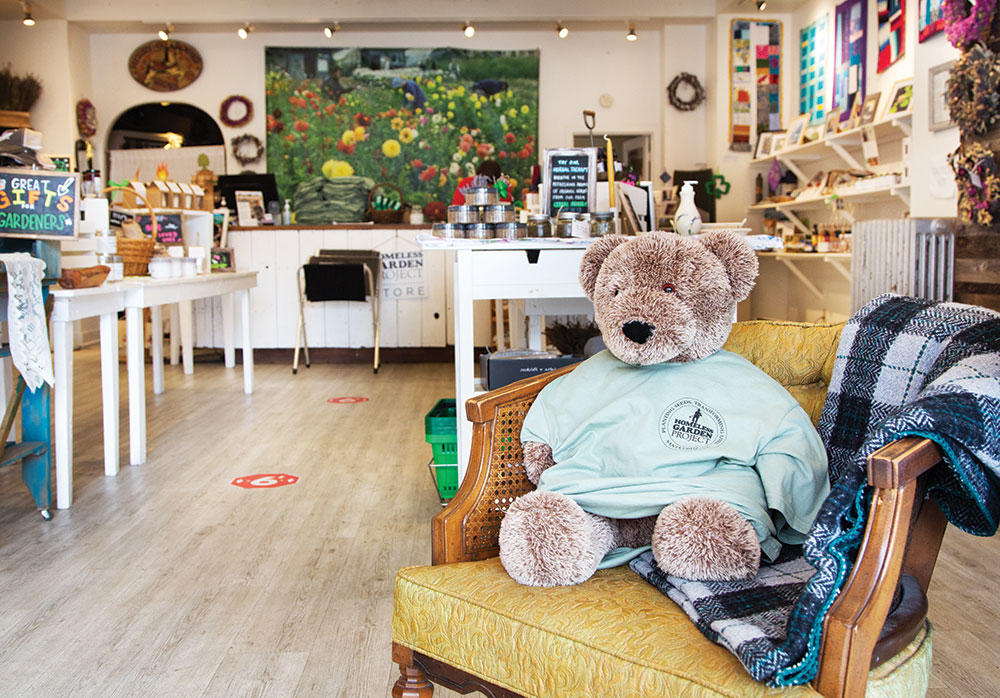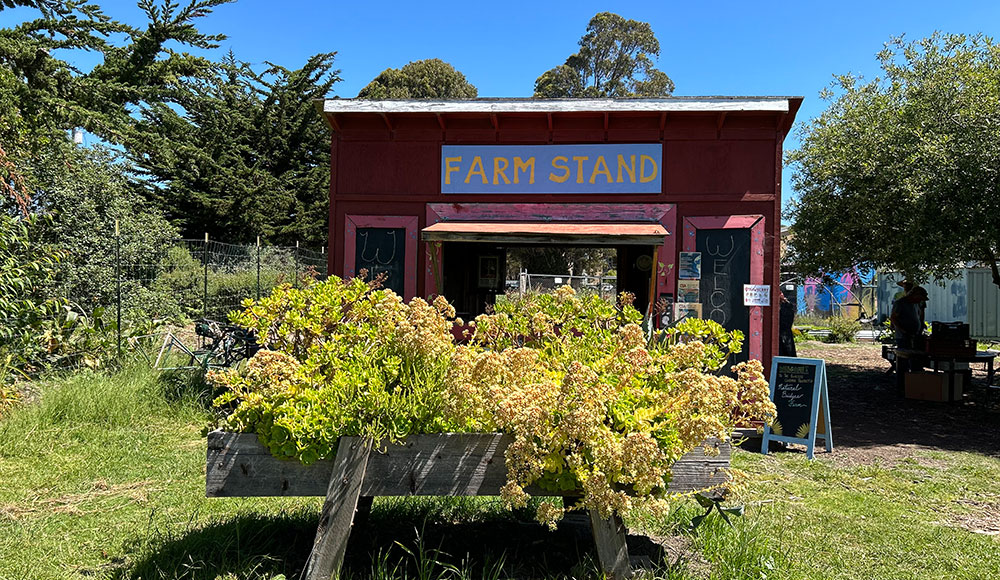Let’s begin with a light reflection. America is at a juncture, not just politically, but systemically. We have a ton of problems, but very few solutions. Our country is struggling under the stress of some weighty issues. Things like addiction, debt, personal crisis, existential dread, sorrow, disease, climate extremes, violence, greed, madness, old age and death. It can, and should, feel overwhelming.
But who shoulders the greatest burden? Who is living at the bottom of this cracked-open Pandora’s Box? Answer: The unsheltered.
More and more people are slipping through the cracks, with 2024 having a record amount of residents on the street. What can be done? One Santa Cruz nonprofit has manifested a functioning cure. It’s a brilliant diamond of an idea that gives a hand up to the neediest. And what is the secret? Well, it’s right below our feet.
We’ve Got to Get Back to the Garden
Since 1990, the Homeless Garden Project has been working with unsheltered human beings who found the street to be their only option. Executive Director Darrie Ganzhorn has a dark tan, with wise and compassionate eyes. She sits surrounded by fields of beans, strawberries and lavender. It’s noon and the farm is busy. Trainees (as those who are unsheltered with jobs are called) wear wide-brim straw hats, and are buzzing around like worker bees, tending the crops.
Ganzhorn might not see herself as the Queen Bee, but her kind engagement, and love for telling the history of the Homeless Garden Project (HGP), is compelling.
“It was co-started with Paul Lee, who was a professor at UCSC. Lee had his PhD from Harvard and was an avid gardener,” Ganzhorn relates from the middle of the farm, near Seymour Marine Labs. Lee organized the very first homeless shelter in Santa Cruz and went on to cofound HGP with Lynne Cooper.
“They started a garden on Pelton Avenue, between Lighthouse and Laguna. And there was much discussion on who could benefit the most from the garden,” Ganzhorn says.

It’s Nature’s Way
If you bounce around from Rachel Carson’s Silent Spring to Edward Abbey’s The Monkey Wrench Gang to Ronald Reagan’s misstated but essentially accurate quote, “If you’ve seen one redwood, you’ve seen them all,” you know that America has wildly differing attitudes toward nature. And in 2024 while so many feel depressed and alienated from being connected (not just the unsheltered) we have the ability to find our meaning, or at least “a” meaning, in farming and connecting to nature.
In his 1995 book Ecopsychology: Restoring the Earth, Healing the Mind, Robert Greenway wrote: “Ecopsychology is a search for language to describe the human-nature relationship. It is a tool for better understanding the relationship, for diagnosing what is wrong with that relationship, and for suggesting paths to healing.”
The Homeless Garden Project aims to auto-correct our waywardness, by digging the path back to nature, and cherishing our role as stewards.
Volunteers of America
“I started in ’91 during the first year, and I was instantly attracted to what was going on here. The idea that we could make positive social change was huge. Even bigger was the idea that I could help,” Ganzhorn says. “Homeless Garden Project manifested the brilliance of farming as a way of supporting people to move out of homelessness. The mission was getting back to basic needs, connecting with the earth, farming together and building community.”
Like the tenets of Ecopsychology infer, when people connect with the earth, there can be transformation.
“There is sort of a real spiritual level to what’s happening here in terms of supporting people, making them feel (perhaps for the first time in their lives) that they belong to a community. We call it the Homeless Garden Project, but our mission is people. We help people find the tools they need to thrive,” Ganzhorn says.
Ganzhorn and everyone involved, from trainee to board member, work tirelessly on the mission, and they have recently been awarded a grant by the California State Initiative called California Regional Initiative for Social Enterprise, aka CA RISE. By expanding fair-chance hiring opportunities, HGP has been recognized as a leading social enterprise in the state of California.
There’s a beautiful symmetry to the Homeless Garden Project. Trainees work the garden from sprouts, tilling, adding nutrition to the soil, and babying the plants until they yield bounty. From there everything is harvested, made into sellable products and sold through various entities like the Homeless Garden Store. If you know about the farm, you might think that the end product is the basket of strawberries, or the soap, at their shop on Pacific Avenue. But you would be overlooking the real results. Take a second to look into the eyes of the Trainees, and you can see what HGP is really all about: changing lives.

I Got Some Time to Hear Your Story
Trainee Frank Daly exudes the presence of a man who found a second chance and has no intention of letting it go. He could be 37, he could be older. He was a recovering addict who got out of lock-up for substance abuse.
“Two years ago I went to jail for a few months. When I got back on the streets of Santa Cruz, I went to Janus and got an ankle monitor. I had a daughter about that time and I decided to get my stuff together. I went to Janus, got into an SLE (Sober Living Environment) and then found a job here. It helps me keep my mind off things. I network and meet people not using drugs or alcohol. A lot of them share the same thing, as you know, being homeless. But we all have, you know, we’re all out here workin’,” says Daly.
Being able to reconnect with his daughter has Daly testifying that HGP is the best thing that has ever happened to him.
Find the Price of Freedom
Recently hired transplant Adam Lovell is hustling on the farm just like everyone else. But Lovell has a home and a partner and recently moved to Santa Cruz to be the HGP farm manager. Lovell is upbeat and talks fast.
“We do some of our most powerful outreach at the library downtown. If you have ID and fill out the employment paperwork, there is a two-week trial period on Tuesday through Friday, 9am to 2pm. If they really make a commitment to showing up on time every day during the trial, afterward there is another application and a job interview,” says Lovell.
Besides the trainees, community support is an essential key to the success of HGP.
“We have an online store and we have a few local wholesale partners. New Leaf is an incredible partner. We work with people who understand an enterprise like ours that is serving people with barriers to employment,” Lovell concludes.
We’re Changing Day to Day
According to Ganzhorn, the HGP program has 25 positions for trainees, who work for one year. In 2023, 91% of the graduating trainees found jobs, and 83% got into housing programs.
HGP is the kind of program that could become nationwide and be on course to easing the crisis of the unsheltered. HGP feeds 110 Community Supported Agriculture (CSA) members, has fundraising and social awareness events on the farm, and is always in need of volunteers. That’s not to mention the networking, the new programs, as well as, the never-ending search for grants and donations.
Of course, besides meaningful employment and finding fellowship, the greatest challenge to the unsheltered, is, no surprise, shelter.
“That’s one of the things that we’re working on right now is where can we support our trainees to have a place to live? We have a project called Finding Flatmates, where we are looking for community members who have a room to rent, and then we’re matchmaking with our trainees who are making a small income here, and can pay some rent. You think about the stability that having housing would provide to somebody while they’re in this program. We’re also working with a group of people on another project. A little bit too soon to talk about it, but it would be housing for transitional employment programs in in the community,” Ganzhorn says.
Despite the seemingly endless amount of tasks, chores and deadlines one faces on a farm, Ganzhorn remains sanguine.
“Riches are to be gained from bringing people up—from helping others. I think that’s why we’re on the planet, personally, is to help other people and then through that to learn about ourselves.”
The Homeless Garden Stores are located downtown at 1338 Pacific Ave. and in Capitola at 222 Esplanade. Hours vary so check the website at homelessgardenproject.org The farm is located at Shaffer Road at Delaware Ave. and is open dawn to dusk.
First Friday with HGP
To celebrate a facelift at its downtown Santa Cruz store and the rollout of a new line of locally made products, the Homeless Garden Project welcomes the community to an event during First Friday, taking place Oct. 4 from 6 to 9pm at 1338 Pacific Ave.
The celebration marks a significant milestone for HGP: a new state grant that will expand the organization’s efforts to provide transformative job training and employment opportunities for individuals experiencing homelessness. A special presentation at 7pm will feature Santa Cruz County Supervisor Justin Cummings, Santa Cruz Mayor Fred Keeley and HGP Production Trainee Charles Stange.
First Friday artist Wendy Ballen will showcase her work, and there will be beer provided by Humble Sea Brewing Co., local wine and samples of HGP products using produce grown on the farm.














